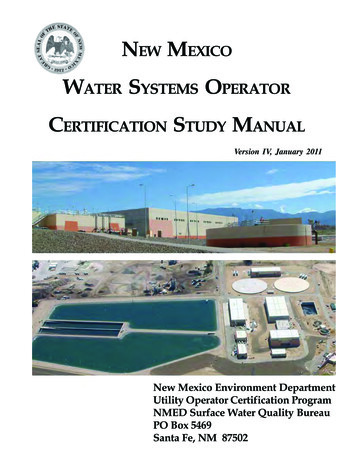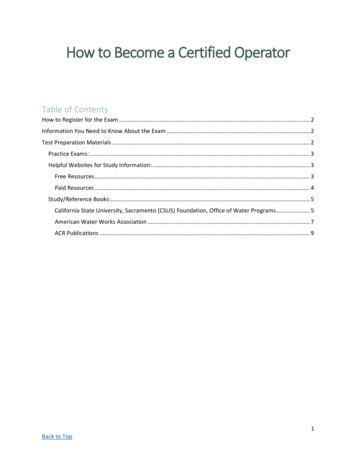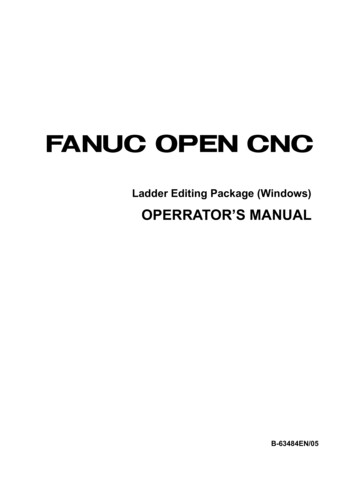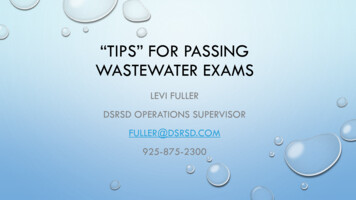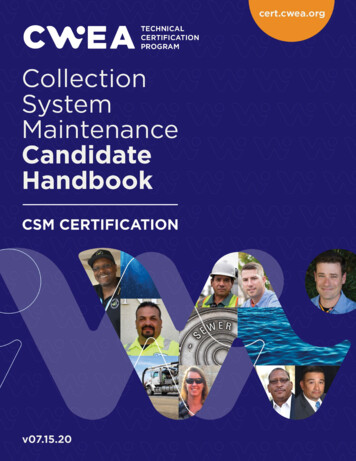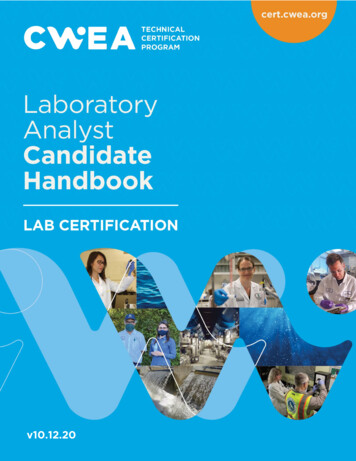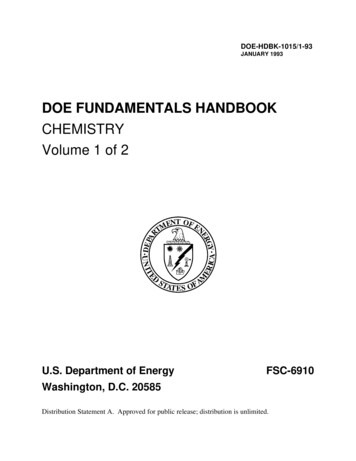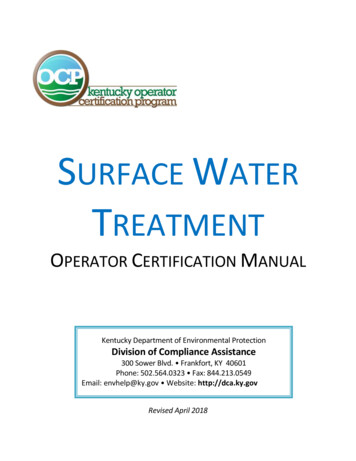
Transcription
SURFACE WATERTREATMENTOPERATOR CERTIFICATION MANUALKentucky Department of Environmental ProtectionDivision of Compliance Assistance300 Sower Blvd. Frankfort, KY 40601Phone: 502.564.0323 Fax: 844.213.0549Email: envhelp@ky.gov Website: http://dca.ky.govRevised April 2018
SURFACE WATER TREATMENT OPERATOR CERTIFICATIONPage 2
SURFACE WATER TREATMENT OPERATOR CERTIFICATIONCertification and Licensing ProgramMissionPromote responsible environmental stewardship.GoalProvide operators with the basic knowledge required to manage drinking water,wastewater and solid waste systems.The Division of Compliance Assistance offers free compliance assistance. Our services areavailable to all individuals, communities and businesses regulated by the KentuckyDepartment for Environmental Protection. We want to help you succeed!Phone number and Website for regulatory, technical or operational concerns502-782-6189dca.ky.govOther programs administered by the Division of Compliance Assistance:Kentucky Excel ProgramKentucky Brownfield ProgramKentucky Environmental Compliance Assistance ProgramDisclaimerAll reasonable precautions have been taken in the preparation of this document, includingboth technical and non-technical proofing. The Kentucky Division of Compliance Assistanceand all staff assume no responsibility for any errors or omissions. Should the summarizedinformation in this document be inconsistent with a governing rule or statute, thelanguage of the rule or statute shall prevail. Reference herein to any specific commercialproducts, process, or service by trade name, trademark, manufacturer, or otherwise, doesnot necessarily constitute or imply its endorsement, recommendation, or favoring by theKentucky Division of Compliance Assistance.Page 3
SURFACE WATER TREATMENT OPERATOR CERTIFICATIONSURFACE WATER TREATMENT OPERATOR CERTIFICATION COURSEChapter 1: THE SURFACE WATER TREATMENT PLANT OPERATOR . 6Chapter 2: WATER SOURCES. 20Chapter 3: WATER CHARACTERISTICS and CHEMISTRY . 28Chapter 4: COAGULATION . 53Chapter 5: FLOCCULATION . 72Chapter 6: SEDIMENTATION . 81Chapter 7: ALTERNATIVE TREATMENT PROCESSES . 99Chapter 8: FILTRATION . 129Chapter 9: DISINFECTION . 181Chapter 10: BACTERIOLOGICAL MONITORING . 216Chapter 11: IRON AND MANGANESE . 223Chapter 12: TASTE and ODOR CONTROL . 229Chapter 13: FLUORIDATION . 238Chapter 14: STABILIZATION . 244Chapter 15: CROSS CONNECTIONS . 251GLOSSARY . 273APPENDIX . 295REFERENCES . 319FORMULA & CONVERSION SHEET . 321Page 4
SURFACE WATER TREATMENT OPERATOR CERTIFICATIONThis page left blank intentionally.Page 5
SURFACE WATER TREATMENT OPERATOR CERTIFICATIONChapter 1: The SurfaceWater Treatment PlantOperatorChapter 1 Objectives1. Explain when and why operator certification came into existence.2. Determine what constitutes a public water system.3. Understand and be able to notate the size parameters relative to certificationclassifications of treatment facilities.4. Recall the number of continuing education hours necessary to renew operatorcertifications.5. Remember the grace period and monetary penalty of failing to renew operatorcertification on time.6. Explain the notions of professionalism and ethical behavior.Page 6
SURFACE WATER TREATMENT OPERATOR CERTIFICATIONHistoryWhen the Cuyahoga River in Cleveland, Ohio, caught fire for the fifth time on June 22,1969, people began complaining about the abysmal condition of the waters in the UnitedStates. Publicity from this event was a major impetus for the passage of the Clean WaterAct (CWA) in 1972. This statute employs a variety of regulatory and nonregulatory tools tosharply reduce direct pollutant discharges into waterways, finance municipal wastewatertreatment facilities and manage polluted runoff.The CWA was followed up by the Safe Drinking Water Act (SDWA) in 1974, in order toprotect the quality of both actual and potential drinking water in the United States. Thisstatute requires the United States Environmental Protection Agency (EPA) to regulate all“public water systems.” This regulation included Maximum Contaminant Levels (MCL) andMaximum Contaminant Level Goals (MCLG) for each regulated contaminant. The SDWAwas amended in 1986 to address, among other things, the regulation of lead levels insolder and flux and defined “lead-free” pipes. In 1996, the act was further amended toemphasize sound science and risk-based standard setting, small water supply systemflexibility and technical assistance, community-empowered source water assessment andprotection, public right-to-know and water system infrastructure assistance through astate revolving loan fund (SRF). Further revisions to the SDWA in 1996 included thefollowing:Page 7
SURFACE WATER TREATMENT OPERATOR CERTIFICATIONConsumer Confidence Reports (CCR) that all community water systems must distributeannually about the water they provide, including information on detected contaminants,possible health effects and the water’s source;Cost-Benefit Analysis, which mandates that the EPA conduct a thorough cost-benefitanalysis for every new standard to determine whether the benefits of a drinking waterstandard justify the costs associated with them;Drinking Water State Revolving Funds (SRF), which states can use to help watersystems make infrastructure or management improvements or to help systems assess andprotect their source water;Microbial Contaminants and Disinfection Byproducts (DBP), which required the EPA tostrengthen protection for microbial contaminants, including cryptosporidium, whilestrengthening control over the byproducts of chemical disinfection.Operator Certification where water system operators must be certified to ensure thatsystems are operated safely. In 1999, the EPA issued guidelines specifying minimumstandards for the certification and recertification of the operators of community and nontransient, noncommunity water systems. All states are currently implementing EPAapproved operator certification programs.Public Information and Consultation: The SDWA emphasizes that consumers have aright to know what is in their drinking water, where it comes from, how it is treated andhow to help protect it and established a Drinking Water Hotline among other resources.Small water systems are given special consideration and resources under the SDWA, tomake sure they have the managerial, financial and technical ability to comply withdrinking water standards.Public water systems (PWS) are defined by the EPA as “a system for the provision tothe public of water for human consumption through pipes or other constructedconveyances, if such a system has at least 15 service connections or regularly serves atleast 25 individuals.”Page 8
SURFACE WATER TREATMENT OPERATOR CERTIFICATIONWhy Should I Become a Certified Operator?Wastewater and drinking water system operators are front-line environmentalprofessionals who ensure the quality of Kentucky's water resources and protect thepublic's health. Only operators that are certified by the Kentucky Certification andLicensing Branch can be in responsible charge of a wastewater or drinking water system.Working in the water and wastewater industry can be extremely rewarding as youwill be providing a critical service to your community. It just might be one of the mostimportant positions in the world since no one can live without water. It takesknowledgeable, conscientious people to deliver clean, potable water and ensure thatwastewater is treated and returned as clean water to the environment.Certification ProcessCertification is obtained by meeting minimum education and experiencerequirements, submitting the appropriate forms and fee and by passing the certificationexamination with at least a 70%. Regulations pertaining to the certification of drinkingwater and wastewater system operators are located in 401 KAR Chapter 11.System ClassificationsA Subclass “A” system is a system that treats:Surface water or groundwater under the direct influence of surface water; orGroundwater not under direct influence of surface water that uses gravity filtration.Class I-ADWater treatment plant with a design capacity 50,000 gallons per dayClass II-AWater treatment plant with a design capacity 50,000 but 500,000gallons per dayClass III-AWater treatment plant with a design capacity 500,000 but 3,000,000gallons per dayClass IV-AWater treatment plant with a design capacity 3,000,000 gallons per dayPage 9
SURFACE WATER TREATMENT OPERATOR CERTIFICATIONRegulatory Education and ExperienceClass I-ADClass II-AClass III-AClass IV-AHigh School Diploma or GED and One (1) year of acceptable operationof a Subclass A public water system with any design capacity shall berequired.High School Diploma or GED and Two (2) years of acceptableoperation of a water treatment plant with Six (6) months in a ClassIIA, IIIA or IVA water treatment plant shall be required.High School Diploma or GED and Three (3) years of acceptableoperation of a water treatment plant with One (1) year of thatexperience in a Class IIA, IIIA or IVA water treatment plant shall berequired.Baccalaureate degree in engineering, science or equivalent is requiredand One (1) year of acceptable operation of a Class IIIA or IVA publicwater treatment plant shall be required. Substitutions for experiencein lieu of a degree will be considered by the cabinet.Operators in Training (OIT) CertificationsOperators in training certifications are available for each certification type. Anindividual can apply for an OIT license that is one level higher and of the same type as thecertification that the individual currently holds. An individual may also apply for an entrylevel OIT certification. OITs must pass the appropriate operator certification exam andwork under the responsible charge of a mentor. To apply for the exam, individuals mustsubmit the following to the Certification and Licensing Branch: Education and Experience Documentation Form;Registration Form for Exams and Training;The appropriate fee; andA letter from the applicant’s mentor. The letter from the mentor must include:o A commitment to oversee the applicant’s work after the applicant becomes anOIT;o A commitment to mentor the applicant as long as the applicant is under thementor’s direct responsible charge;o Verification that the mentor is not currently mentoring any other OITs; ando Confirmation that the mentor holds a certification license that is equal to orgreater than the certification level required to serve in primary responsibility ofthe facility where the mentor and prospective OIT works.Page 10
SURFACE WATER TREATMENT OPERATOR CERTIFICATIONCertification Renewal or MaintenanceDrinking water treatment, distribution and bottled water system certificationsexpire on June 30 of even-numbered years. Certifications shall remain valid until theexpiration date, unless suspended, revoked or replaced by a higher classificationcertificate before that date. Certificates issued between Jan. 1 and June 30 of a renewalyear will be issued to include the next two-year renewal period. Failure to renew beforeJuly 1 of the renewal year will result in the expiration of certification and a late feeassessment. The certificate shall terminate if not renewed on or before Dec. 31 of theyear the certification expired. Certified operators with expired certificates shall not be inresponsible charge of a drinking water or wastewater facility.Certified operators (excluding OIT certificates) may renew their license(s)electronically through the cabinet website using the E-Search link or by submitting theApplication for Certification Renewal and appropriate fee to the Division of ComplianceAssistance, Certification and Licensing Branch, 300 Sower Blvd., Frankfort, KY 40601.Certified operators who are designated an Operator in Training may renew acertification without examination if the operator has: Satisfied the continuing education requirements; Earned the required years of operational experience; Submitted an Education and Experience Documentation form verifying hisor her experience; Submitted a letter of recommendation from a mentor; and Submitted a completed Application for Certification Renewal form and therenewal fee to the cabinet or has renewed the certification electronically onthe cabinet's website.Drinking water treatment, distribution and bottled water certified operators’training hours shall be completed for each renewal during the two (2)-year periodimmediately prior to the certificate expiration date. Certified operators holding atreatment, distribution and/or bottled water certificate shall complete the requirednumber of cabinet-approved training hours for the highest certificate held in lieu ofcompleting the required number of continuing education hours required for bothcertificates.Reminder -- Continuing education hours earned prior to certification shall notcount toward certificate renewal.Page 11
SURFACE WATER TREATMENT OPERATOR CERTIFICATIONOperator Ethics – Standards of Professional Conduct for Certified OperatorsIn order to safeguard the life, health and welfare of the public and theenvironment and to establish and maintain a high standard of integrity in the certifiedoperator profession, standards of professional conduct apply to persons certified inaccordance with 401 KAR Chapter 11. These standards state that:(a) A certified operator shall, during the performance of operational duties, protectthe safety, health and welfare of the public and the environment;(b) A certified operator shall use reasonable care and judgment in the performance ofoperational duties;(c) If a certified operator’s judgment is overruled by an employer under circumstancesin which the safety, health and welfare of the public or the environment areendangered, the certified operator shall inform the employer of the possibleconsequences;(d) A certified operator shall be objective, truthful and complete in applications,reports, statements and testimony provided to the cabinet; and(e) A certified operator shall ensure the integrity of the samples that the operatorcollects, prepares or analyzes so that results shall be a true representation of waterquality.The full set of standards is located in 401 KAR 11:020.Certified operators who violate the standards in 401 KAR 11:020 are subject todisciplinary actions which include but are not limited to:(a) Probation of the operator's certification for a specified period of time, not toexceed one (1) year;(b) Suspension of the operator's certification for a specified period of time, not toexceed four (4) years, during which the certification shall be considered void;(c) Revocation of the operator's certification;(d) Civil or criminal penalties; or(e) A combination of the disciplinary actions listed above.Disciplinary actions are outlined in 401 KAR 11:050, Section 4.All regulations related to the certification of wastewater and drinking water operators arelocated in 401 KAR Chapter 11. A copy of the regulations is located in this manual, and it isrecommended that you become familiar with the regulations that govern your profession.Page 12
SURFACE WATER TREATMENT OPERATOR CERTIFICATIONProfessionalismProfessionalism is the skill, competence or character expected of a member of ahighly trained profession and the use of professionals instead of amateurs.We are in a low-visibility PROFESSION and our customers don’t know howimportant our work is to their well-being.We operators need to regard our profession as a PROFESSION, not just a job, andtake our cues from other professionals.Be proud of your profession. You, as an operator, provide one of the resources thathuman beings need to survive.The purpose of treatment is to provide POTABLE WATER fit for humanconsumption to our customers.KNOWLEDGE YOUR DILIGENCE POTABLE WATERSOURCE WATER QUALITY TREATMENT FINISHED WATER QUALITYMonitor CloselyControlled ChangeSet GoalsThis formula for treating water is true and accurate for all systems.SOURCE WATER FACILITIES TREATMENT TECHNIQUESince source waters are so different, treatment facilities and techniques will be different,as well. For this reason there is no “one size fits all” or quick fix that will work for allsource waters or facilities. What works at one treatment facility will not necessarily workat another. Furthermore, what works at your facility today may not work nearly as welltomorrow when the source water changes.Page 13
SURFACE WATER TREATMENT OPERATOR CERTIFICATIONThe focus of operation should be: Set finished water goals.Monitor closely all affective raw water quality changes.Understand the operational theory and design characteristics of your facility.Monitor and evaluate all factors that affect each treatment process.Take into account the big picture; recognize the interaction between processes.Measure and evaluate the results of all changes.Continuously strive to improve yourself as an operator.“You can’t build a reputation on what you are going to do.”– Henry FordPage 14
SURFACE WATER TREATMENT OPERATOR CERTIFICATIONList of Key rican Water Works AssociationAmerican Water Works Research FoundationBiologically Active CarbonBest Available TreatmentBest Management PracticeComprehensive Performance EvaluationKentucky DOW Comprehensive Technical Assistance ProgramDisinfection By - ProductDisinfectant and Disinfection by – ProductDisinfectant and Disinfection by – Product RuleDissolved OxygenDivision of Water (Kentucky)Effective SizeEnhanced Surface Water Treatment RuleGranular Activated CarbonGround Water RuleGround Water Under the Direct Influence of Surface WaterInterim Enhanced Surface Water treatment RuleIndividual Filter EffluentsLead and Copper RuleLong Term Enhanced Surface Water Treatment RuleLong Term 2 (Enhanced Surface Water Treatment Rule)Magnetic Resin (trademark acronym for a resin specific for DOC removal)Mixed OxidantsMillion Gallons per DayMonthly Operating ReportMaximum Residual Disinfectant LevelNatural Organic MatterNational Pollutant Discharge Elimination SystemOperations and MaintenanceOxidation Reduction PotentialPublic Water SystemQuality AssuranceQuality ControlRural Community Assistance PartnershipRevised Total Coliform RuleSupervisory Control and Data AcquisitionSpecific GravityPage 15
SURFACE WATER TREATMENT OPERATOR HPASynthetic Organic CarbonSpecific Ultraviolet AbsorbanceSurface Water Treatment RuleTotal ColiformTotal Coliform RuleTotal Dissolved SolidsTotal Organic CarbonUniformity CoefficientUnited States Environmental Protection AgencyUnited States Geological SurveyWater Treatment PlantWell Head Protection AreaPage 16
SURFACE WATER TREATMENT OPERATOR CERTIFICATIONReview Questions for Chapter 1 – The Surface Water Treatment PlantOperator1. Identify when the SDWA was enacted?2. Identify when the operator certification process was federally mandated?3. Operators have how many months to renew their license without having to retest?4. What are operators bound by regulation to do if they are told to do somethingillegal?Page 17
SURFACE WATER TREATMENT OPERATOR CERTIFICATIONAnswers to Review Questions for Chapter 1 – The Surface Water TreatmentPlant Operator1. 19742. 19963. Six months4. Inform whoever gave the order of the consequences.Page 18
SURFACE WATER TREATMENT OPERATOR CERTIFICATIONThis page left blank intentionally.Page 19
SURFACE WATER TREATMENT OPERATOR CERTIFICATIONChapter 2: Water SourcesThe Hydrologic CycleChapter 2 Objectives1. Define the hydrologic cycle and be able to recall the movements of water that areentailed within.2. Delineate the three types of source water and the differences between them.3. Determine what entities make up the EPA “Multiple Barrier Approach” to waterquality.4. Determine which type of source water is the easiest to remediate.Page 20
SURFACE WATER TREATMENT OPERATOR CERTIFICATIONThe Hydrologic CycleEvaporation – A process in which something is changed from a liquid to a vapor withoutits temperature reaching the boiling point.Precipitation – The formation of rain, snow, hail, etc., from moisture in the air.Runoff – Water, sometimes carrying agricultural or industrial wastes, that is carried byrainfall and melting snow into surface waters.Infiltration - Water passing through the soil and recharging aquifers.Percolation – Making a liquid pass through a filter (soil and rock) or porous substance.Transpiration – A process where water vapor is given off to the atmosphere by a plant’ssurface ( leaves, exposed roots, etc.).Page 21
SURFACE WATER TREATMENT OPERATOR CERTIFICATIONCurrent federal drinking water regulations define three distinct and separate sources ofwater: 1) surface water, 2) groundwater under the direct influence of surface water, and3) groundwater.Surface WaterSurface water is water that is open to the atmosphere and results in overland flow.Much of this water is the result of surface runoff. Specific sources of supply include rivers,lakes, streams, springs, shallow wells and manmade impoundments.Surface waters are easily polluted (or contaminated) with harmful chemicals andpathogenic microorganisms that cause diseases in humans. These harmful entities canenter surface water sources from runoff and upstream discharges.The turbidity of surface water often fluctuates relative to the amount ofprecipitation that can increase treatment requirements, costs and the need of operatordiligence.The temperature of surface water vacillates with the ambient temperature. Thisfluctuation in temperature impacts all chemical and physical treatment processes andmakes consistent water quality more difficult to achieve.Decomposing plant and animal life (organics) are prevalent in surface water.Organics can affect the taste, odor and color of water, and these organics have shownthemselves to be precursors of disinfection by-products. Organics can also acceleratecorrosion rates and greatly increase treatment requirements and associated costs.Water-quality problems, such as hardness, or iron and manganese discoloration asa result of dissolved minerals, occur infrequently in surface water supplies, but canoccasionally be problematic with some waters.Surface water sources are easier to access, pollute and remediate thangroundwater, and quantity can be unstable during droughts.Page 22
SURFACE WATER TREATMENT OPERATOR CERTIFICATIONBecause surface water supplies are so susceptible to pollution and pathogeniccontamination, higher levels of treatment that will include coagulation, flocculation andfiltration will likely be necessary. These processes are a part of the EPA multiple barrierconcept of water treatment.Source Water Protection – Protecting the water before it gets to the treatment facilitymeans less time and money to treat it when it gets to the plant.Distribution – Provide both the quantity and quality of water to our customers.Treatment – Remove potentially harmful chemicals and aesthetically displeasingcontaminantsPage 23
SURFACE WATER TREATMENT OPERATOR CERTIFICATIONGroundwater Under the Direct Influence of Surface WaterGroundwaters under the direct influence (GWUDI) are affected by the sameparameters as surface water, so the levels of treatment are much the same as surfacewater.GroundwaterGroundwater is considered to be water that is below the earth’s crust, which hasbeen stored within an aquifer and does not change in character relative to precipitationevents. An aquifer is an underground layer of water-bearing material. Groundwater isusually brought to the surface by a well.Because of the earth’s abilities to filter water as it travels down to the aquifer, thewater quality of groundwater is generally good. Because of its lack of exposure to theatmosphere, contamination issues are usually much less than those of surface water.Because of its characteristics and the lack of outside influences, groundwater usuallyrequires less treatment than surface water.Page 24
SURFACE WATER TREATMENT OPERATOR CERTIFICATIONReview Questions for Chapter 2 – Water Sources1. What are the six hydrologic cycle processes that transport water around our planet?2. An underground layer of water bearing material is called what?3. Which source water, ground or surface, is easier to remediate?Page 25
SURFACE WATER TREATMENT OPERATOR CERTIFICATIONAnswers to Review Questions for Chapter 2 – Water Sources1. Evaporation, condensation, runoff, infiltration, precipitation, transpiration2. An aquifer3. SurfacePage 26
SURFACE WATER TREATMENT OPERATOR CERTIFICATIONThis page left blank intentionally.Page 27
SURFACE WATER TREATMENT OPERATOR CERTIFICATIONChapter 3: WaterCharacteristics andChemistryChapter 3 Objectives1. Define an MCL, MCLG and associated action levels2. Define an inorganic contaminant and what differentiates it from organiccontaminants. Explain what role both play in drinking water treatment.3. Define pH, and explain its significance in water treatment, how it is measured andthe effects of the differences in measurements, and how to alter or change pHlevels.4. Define alkalinity and what role it plays in water treatment as well as ways tochange alkalinity levels5. Determine how temperature variances could impact both the water being treatedand the treatment processes and how to adapt to such changes.6. Explain how a treatment facility can adapt to significant temperature change.7. Define turbidity and explain its significance in the treatment process as well as howit is measured.8. Define hardness.9. Delineate the types of color and their potential impact on the treatment process,disinfection by-products and customers’ perceptions of their water.10. List the most predominate causes of taste and odor in drinking water and how theyrelate to TOC, NOM and DOC.11. Define TDS and its impact on the treatment process.12. Explain the importance of intake structures to the treatment process, which intakelevel would be superior and the means available to instigate inexpensive solutionsto intake issues.13. Explain what significance stratification has to raw water.Page 28
SURFACE WATER TREATMENT OPERATOR CERTIFICATIONWater Characteristics and ChemistryOne of the first things water treatment operators should learn is the source of thewater entering their plant. The water source affects both the quantity and quality of theraw water to be treated. A basic understanding of how raw water acquires itscharacteristics and how these characteristics will affect human health and necessarytreatment techniques will help operators effectively treat their water.Potable water is water that is safe for drinking purposes from the standpoint of itschemical, physical and biological characteristics. Public water systems’ (PWS) product(potable water), must meet certain federal and state water-quality standards enforced bythe EPA and the Kentucky Division of Water (DOW).Before any system in Kentucky begins offering water for human consumption, itfirst must perform a series of tests on its raw water source(s) to determine 1) what typeof contaminants are present in the raw water 2) how pervasive these contaminants areand 3) the likelihood of the numbers of these contaminants changing over time. Thisinformation is then used to determine what treatment processes are required, CTcalculations, monitoring frequencies and design parameters for plant expansions or fornew treatment facilities.Periodically, water systems undergo sanitary surveys. Sanitary surveys evaluatesource water characteristics, treatment process effectiveness, distribution systemefficiencies, certified operator availabilities and capacity development guidelines.Basic knowledge of water quality, characteristics and treatment processes arenecessary to competently perform the duties of a certified treatment operator. Aftergaining this knowledge, using it on a regular basis will hone your skills and improve yourperformance as well as the performance of the plant.Maximum Contaminant LevelsMaximum Contaminant Levels (MCLs) arePRIMARY MCL’sNITRATE10.0 mg/LFLUORIDE4.0 mg/LLEAD0.05 mg/L *COPPER1.3 mg/L **TUR
Apr 18, 2004 · SURFACE WATER TREATMENT OPERATOR CERTIFICATION Page 11 Certification Renewal or Maintenance Drinking water treatment, distribution and bottled water system certifications expire on June 30 of even-numbered years. Certifications shall remain valid until the expiration date, unless
